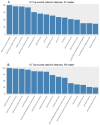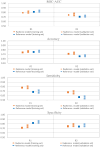Magnetic resonance imaging -based radiomics of the pituitary gland is highly predictive of precocious puberty in girls: a pilot study
- PMID: 39974824
- PMCID: PMC11835667
- DOI: 10.3389/fendo.2025.1496554
Magnetic resonance imaging -based radiomics of the pituitary gland is highly predictive of precocious puberty in girls: a pilot study
Abstract
Background: The aim of the study was to explore a radiomic model that could assist physicians in the diagnosis of central precocious puberty (CPP). A predictive model based on radiomic features (RFs), extracted form magnetic resonance imaging (MRI) of the pituitary gland, was thus developed to distinguish between CPP and control subjects.
Methods: 45 girls with confirmed diagnosis of CPP (CA:8.4 ± 0.9 yr) according to the current criteria and 47 age-matched pre-pubertal control subjects (CA:8.7 ± 1.2 yr) were retrospectively enrolled. Two readers (R1, R2) blindly segmented the pituitary gland on MRI studies for RFs and performed a manual estimation of the pituitary volume. Radiomics was compared against pituitary volume in terms of predictive performances (metrics: ROC-AUC, accuracy, sensitivity and specificity) and reliability (metric: intraclass correlation coefficient, ICC). Pearson correlation between RFs and auxological, biochemical, and ultrasound data was also computed.
Results: Two different radiomic parameters, Shape Surface Volume Ratio and Glrlm Gray Level Non-Uniformity, predicted CPP with a high diagnostic accuracy (ROC-AUC 0.81 ± 0.08) through the application of our ML algorithm. Anthropometric variables were not confounding factors of these RFs suggesting that premature thelarche and/or pubarche would not be potentially misclassified. The selected RFs correlated with baseline and peak LH (p < 0.05) after GnRH stimulation. The diagnostic sensitivity was improved compared to pituitary volume only (0.76 versus 0.68, p<0.001) and demonstrated higher inter-reader reliability (ICC>0.57 versus ICC=0.46).
Discussion: Radiomics is a promising tool to diagnose CPP as it reflects also functional aspects. Further studies are warranted to validate these preliminary data.
Keywords: central precocious puberty; machine learning; magnetic resonance imaging; pituitary gland; precocious puberty, puberty; radiomics.
Copyright © 2025 Maddalo, Petraroli, Ormitti, Fulgoni, Gnocchi, Masetti, Borgia, Piccolo, Turco, Patianna, Sverzellati, Esposito, Ghetti and Street.
Conflict of interest statement
The authors declare that the research was conducted in the absence of any commercial or financial relationships that could be construed as a potential conflict of interest. The author(s) declared that they were an editorial board member of Frontiers, at the time of submission. This had no impact on the peer review process and the final decision.
Figures





References
-
- Pescovitz OH, Eugster EA. Pediatric endocrinology, mechanisms, manifestations and management. Philadelphia: Lippincott Williams & Wilkins; (2004) p. 63–79.
-
- Larsen PR, Kronenberg HM, Melmed S, Polonsky KS. Williams Textbook of endocrinology, puberty ontogeny, neuroendocrinology, physiology and disorders. New York: Elsevier; (2003).
MeSH terms
LinkOut - more resources
Full Text Sources
Medical

